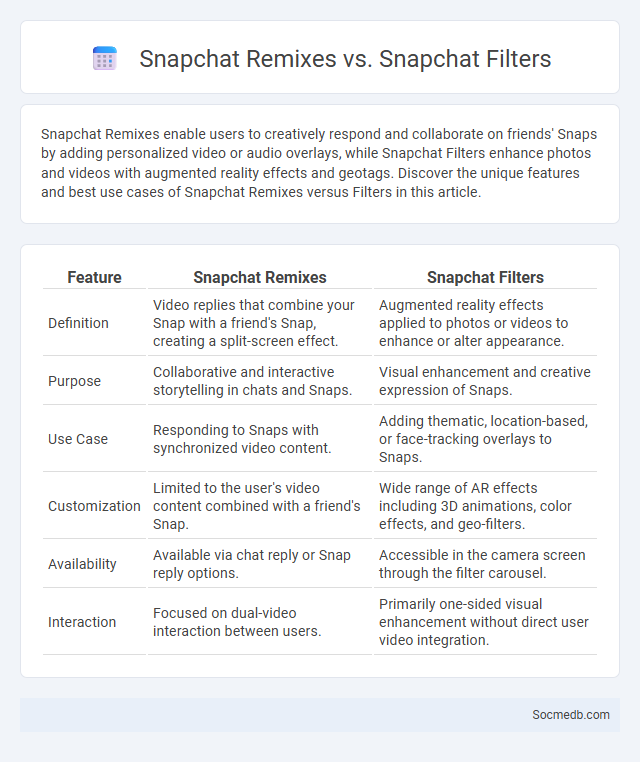
Photo illustration: Snapchat Remixes vs Snapchat Filters
Snapchat Remixes enable users to creatively respond and collaborate on friends' Snaps by adding personalized video or audio overlays, while Snapchat Filters enhance photos and videos with augmented reality effects and geotags. Discover the unique features and best use cases of Snapchat Remixes versus Filters in this article.
Table of Comparison
| Feature | Snapchat Remixes | Snapchat Filters |
|---|---|---|
| Definition | Video replies that combine your Snap with a friend's Snap, creating a split-screen effect. | Augmented reality effects applied to photos or videos to enhance or alter appearance. |
| Purpose | Collaborative and interactive storytelling in chats and Snaps. | Visual enhancement and creative expression of Snaps. |
| Use Case | Responding to Snaps with synchronized video content. | Adding thematic, location-based, or face-tracking overlays to Snaps. |
| Customization | Limited to the user's video content combined with a friend's Snap. | Wide range of AR effects including 3D animations, color effects, and geo-filters. |
| Availability | Available via chat reply or Snap reply options. | Accessible in the camera screen through the filter carousel. |
| Interaction | Focused on dual-video interaction between users. | Primarily one-sided visual enhancement without direct user video integration. |
Understanding Snapchat Remixes: What Are They?
Snapchat Remixes are a dynamic feature allowing users to create personalized versions of existing snaps by adding their own video, text, or audio responses. This interactive tool enhances engagement on the platform by enabling users to remix content from friends or public posts, fostering creative expression and social interaction. Understanding Snapchat Remixes is essential for maximizing content reach and participation within the Snapchat community.
Snapchat Filters Explained: Features and Functions
Snapchat filters enhance user engagement by overlaying real-time graphical effects on photos and videos, utilizing augmented reality (AR) technology to create interactive and personalized experiences. These filters include face-tracking capabilities, geofilters based on location, and sponsored content to boost brand visibility. Advanced features like 3D Bitmoji integration and voice-activated lenses leverage machine learning algorithms for immersive visual storytelling.
The Core Differences Between Remixes and Filters
Remixes on social media involve creatively reinterpreting or combining original content to produce a new, unique piece, often showcasing user innovation and engagement. Filters, in contrast, primarily enhance or alter the visual appearance of photos or videos by applying predefined effects, such as color adjustments, overlays, or augmented reality elements. While remixes emphasize content transformation and originality, filters focus on visual enhancement and aesthetic appeal.
How to Use Snapchat Remixes Step-by-Step
Snapchat Remixes allow you to creatively respond to friends' Snaps by adding your own video alongside theirs, enhancing engagement. To use Snapchat Remixes, open a received Snap, tap the remix button, record your video reaction, and then send it back to your friend for an interactive conversation. Your personalized remixed Snaps enrich your communication and make sharing moments more dynamic on social media.
Customizing Your Snaps With Filters: A Guide
Customizing your snaps with filters enhances visual appeal and personal expression by applying real-time effects tailored to your content style. Popular platforms like Snapchat and Instagram provide a diverse range of filters, including color adjustments, AR effects, and thematic overlays, enabling users to create unique and engaging stories. Utilizing advanced features such as geofilters, face recognition, and interactive lenses helps increase viewer interaction and boost engagement rates on social media posts.
Creative Possibilities: Remixes vs. Filters
Social media platforms offer diverse creative possibilities by enabling users to remix content rather than just apply filters, fostering originality and personal expression. Remixing allows for the integration of multiple media elements, such as videos, sounds, and text, resulting in innovative and collaborative content creation. Filters primarily enhance visual aesthetics, but remixes encourage deeper engagement and adaptability in digital storytelling.
Comparing User Engagement: Remixes vs. Filters
User engagement on social media often differs significantly between remixes and filters, with remixes encouraging more active participation through creative collaboration. Remixes allow users to reinterpret and build upon existing content, boosting interaction rates by fostering community-driven innovation. Your audience is more likely to spend time exploring and contributing to remixed content compared to passively applying filters, which typically enhance visual appeal without driving deeper involvement.
Privacy and Sharing: What to Know About Each Feature
Social media platforms offer various privacy settings that control who can view and share your content, allowing you to customize your audience and protect personal information. Features like friend lists, blocked users, and content visibility options help safeguard your data from unwanted access or exposure. Understanding these settings enables you to share confidently while maintaining control over your online presence.
Popular Trends: Filters and Remixes on Snapchat
Snapchat's popular trends center around innovative filters and creative remixes that engage millions of users daily. Augmented reality (AR) filters enhance selfies with interactive effects, while remix features allow users to combine and modify existing Snaps, fostering creative expression and viral content circulation. These tools drive user engagement and trend propagation, positioning Snapchat as a leader in dynamic, community-driven social media experiences.
Choosing the Right Feature: When to Use Remixes or Filters
Choosing the right feature on social media requires understanding your content goals and audience preferences. Remixes enhance engagement by encouraging user interaction and creativity, making them ideal for trends and collaborative storytelling. Filters, on the other hand, improve visual appeal and brand consistency, perfect for polished, aesthetic-driven posts and campaigns.
 socmedb.com
socmedb.com